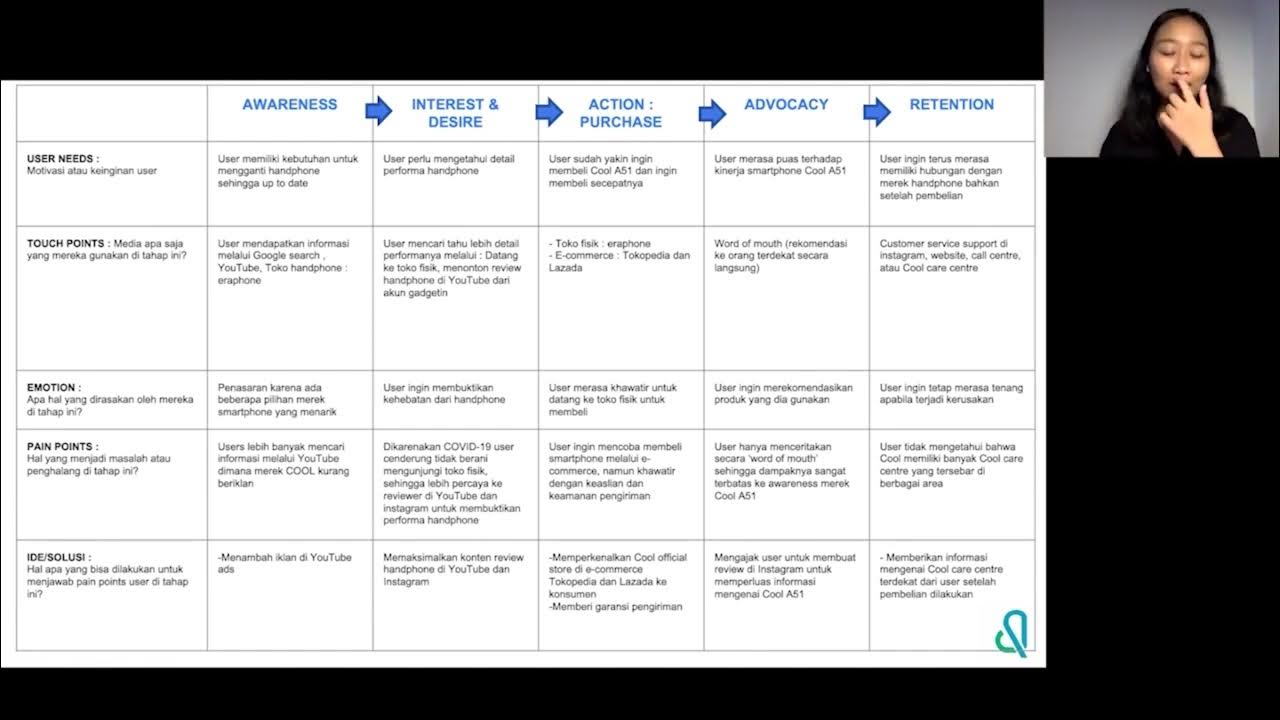Customer Journey
Summary
TLDRThis video provides an in-depth exploration of the customer journey, outlining key moments and touchpoints that influence customer decisions from pre-purchase to post-purchase. It covers how customers are triggered by personal needs, experiences, and external factors like social influences, and details the significance of each interaction with a brand. The importance of managing customer expectations and maximizing satisfaction at every touchpoint is emphasized, alongside guidance on creating customer journey maps. The tutorial includes steps for designing journey maps, from choosing a scope and persona to adding emotional layers and tracking metrics to optimize the customer experience.
Takeaways
- 😀 The customer journey encompasses all events that occur from the moment a customer recognizes a need until after the purchase, including post-purchase experiences that influence loyalty.
- 😀 A customer journey consists of events (triggered moments) and touch points (interactions with the brand), which help shape the customer's experience and decision-making process.
- 😀 Events are broader than touch points, as they can involve customer actions or experiences without direct brand interaction, while touch points are specific interactions like product use or brand communication.
- 😀 Marketing activities should focus on touch points, as they are the moments when the brand interacts directly with the customer, impacting their perception and behavior.
- 😀 There are three key periods in the customer journey: before the purchase (pre-purchase), during the purchase (purchase experience), and after the purchase (post-purchase). Each has decisive moments and touch points that can influence satisfaction and loyalty.
- 😀 Customer decisions in the pre-purchase phase can be influenced by personal experiences, social influences (family, friends, influencers), and commercial marketing efforts.
- 😀 The purchase experience involves various events such as the shopping environment, personal or digital interactions, and the customer's emotional response, all of which impact their satisfaction.
- 😀 The post-purchase period focuses on the product's usage, with customer satisfaction driving loyalty and word-of-mouth promotion. Satisfaction is measured by whether the experience exceeds the customer's expectations.
- 😀 Marketing should aim to manage customer expectations, ensuring that the experience is better than expected without creating unrealistic expectations that lead to dissatisfaction.
- 😀 Creating a customer journey map involves defining the scope, choosing a persona, identifying key steps and events, and adding additional lanes such as emotional responses, marketing activities, and metrics to optimize each touch point and overall satisfaction.
Q & A
What is the customer journey?
-The customer journey is the series of events that occur during a customer's decision-making process, from the initial realization of a need to the final purchase, which may lead to either satisfaction or dissatisfaction. It also includes post-purchase interactions, loyalty, and the customer lifetime cycle.
What are the key components of the customer journey?
-The customer journey is made up of events and touch points. Events are moments when a customer is triggered to act in the purchase process, while touch points are moments when the customer interacts with the brand, such as purchasing, using the product, or hearing about the brand through various media.
How do events and touch points differ?
-Events are broader than touch points. Events can include moments when the customer is involved in the process but is not in direct contact with the brand, such as realizing a need. Touch points, however, are specific moments when a customer interacts with the brand, such as through product use, advertising, or direct communication.
What are the three main stages of the customer journey?
-The three main stages of the customer journey are the pre-purchase period, the purchase experience, and the post-purchase period. Each stage includes key touch points and events that influence customer satisfaction and behavior.
Why is customer satisfaction crucial in the customer journey?
-Customer satisfaction is critical because it leads to loyalty and repeat purchases. Satisfaction occurs when the customer’s experience exceeds their expectations. Marketing plays a key role in managing these expectations to avoid dissatisfaction or unfulfilled potential.
What role does marketing play in the customer journey?
-Marketing plays a vital role in guiding the customer through each touch point by creating positive interactions. It involves managing customer expectations, telling the brand story, and strategically intervening at key touch points to maximize customer satisfaction.
What is a customer journey map?
-A customer journey map is a visual representation of the customer journey that outlines key events and touch points along with the customer’s emotions, actions, and experiences. It helps organizations understand and improve customer interactions across all stages of the journey.
What are the steps to creating a customer journey map?
-The steps to creating a customer journey map include determining the scope, choosing a persona to represent the main actor, identifying key experiences or steps, adding lanes for additional insights (e.g., emotions, marketing activities), and refining the map to communicate the insights effectively.
What is the importance of the scope in a customer journey map?
-The scope determines the level of detail and focus of the customer journey map. A broad scope may cover the entire customer lifecycle, while a narrow scope may focus on a specific step, such as comparing products or a one-hour consultation.
How can the emotional journey be represented in a customer journey map?
-The emotional journey can be represented by adding an emotional journey lane to the map, showing the customer’s feelings at each touch point. This helps identify moments of satisfaction or frustration, which are critical for optimizing the customer experience.
Outlines

Cette section est réservée aux utilisateurs payants. Améliorez votre compte pour accéder à cette section.
Améliorer maintenantMindmap

Cette section est réservée aux utilisateurs payants. Améliorez votre compte pour accéder à cette section.
Améliorer maintenantKeywords

Cette section est réservée aux utilisateurs payants. Améliorez votre compte pour accéder à cette section.
Améliorer maintenantHighlights

Cette section est réservée aux utilisateurs payants. Améliorez votre compte pour accéder à cette section.
Améliorer maintenantTranscripts

Cette section est réservée aux utilisateurs payants. Améliorez votre compte pour accéder à cette section.
Améliorer maintenant5.0 / 5 (0 votes)






